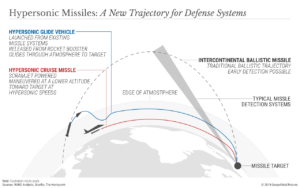 By George Friedman July 10, 2019 Geopolitical Future
By George Friedman July 10, 2019 Geopolitical Future
Indispensable Sea Lanes
Command of the sea guarantees security and trade. Ancient Rome certainly understood as much, focused as they were on controlling Mare Nostrum (or Our Sea, referring to the Mediterranean), which forced North African threats like Carthage to attack Rome on its flanks and ensured access to Egyptian crops. The land routes around the Mediterranean were powerful but slow. The naval routes were rapid but lighter, and commercially, they were indispensable.
China and Iran are now trying to secure their sea lanes, or at least deny others access to them. For China, now a massive trading power, access to the world’s seas is an economic necessity. Its fear is that the United States could try to blockade China and, in doing so, strangle the Chinese economy (and keep in mind, the worst-case scenario is historically not the least likely one). Iran, which is hobbled by U.S. sanctions, does not have the political or naval power to break the blockade, but it does have the wherewithal to launch a counter-blockade of the Strait of Hormuz. The vast amounts of oil flowing through the strait are essential to many U.S. allies, and successfully blocking the strait would cause an economic crisis followed by a crisis in the alliance. Sanctioning Iran, therefore, might prove too costly for the United States. So long as trade is carried out on the seas, control of the seas is essential.
Historically, command of the sea depended on surface vessels, powered by oars, sails, coal, oil and so forth. The operational principle of national power was the possession of a sufficient fleet to overwhelm the enemy primarily in size and weaponry. The high point of this ancient concept of naval warfare was the battleship, a massive and expensive vessel, carrying a handful of guns able to fire large munitions at long range. Surface warfare had reached its peak with the battleship. Its cost would cripple a mid-sized country’s economy. It could defeat any ship it encountered, save another battleship. The race was in size, armor and munitions, and whichever country had the most could protect its maritime interests.
The foundation of naval tactics was therefore the surface vessel against the surface vessel. This was replaced not by any advancement in the power of battleships but by the introduction of a new concept in naval warfare: air power. Whereas battleships fought by firing salvos of large shells at enemies, aircraft could fire small explosive shells that impacted the surface and torpedoes that hit battleships below the waterline. Another threat came from submarines.
Starting with the British attack on the Italian fleet at Taranto, and culminating with the Japanese attack on Pearl Harbor, vessels designed to carry torpedoes and bombs devastated battleships in harbors. Very rapidly, the center of gravity of naval warfare shifted to the aircraft carrier and was supplemented by the submarine, which was designed to break the supply chain in the North Atlantic and Western Pacific.
This combination of aircraft carriers and submarines had been at the heart of naval warfare for nearly a century, but new munitions eventually challenged their primacy. Specifically, the introduction of precision-guided munitions increased the vulnerability of the carrier. These are not ballistic missiles; once fired, their direction could be corrected, making them much more accurate than the older missiles. In 1967, a Soviet Styx missile fired from Egypt sank an Israeli destroyer, the Eilat. The accuracy was stunning, as was the warhead’s effect.
The sinking of the Eilat forced many to second guess the aircraft carrier. The assumption had been that fighters could provide protection to carriers. Enemy aircraft had to fly into the combat air patrol’s space to deliver iron bombs and torpedoes. The Eilat incident showed that this was not necessary. A PGM fired from shore – or by an aircraft standing outside the air defense space of fighters, anti-air guns and missiles – could sink or wreck ships.
One way to defend against this was to expand the fighter space, but as this happens, it outstrips the availability of fighters. The focus turned, then, from shooting down attacking planes to destroying incoming missiles. Systems like the American Aegis were created, at enormous expense, to do so. No system is perfect, so keeping attackers at a distance remained critical. The cost of this was a massively increased number of advanced vessels designed to provide air defense and anti-submarine warfare capability. The carrier battle groups cost many billions of dollars in initial development and maintenance, to allow 30-70 attack aircraft to fly toward a target and fire PGMs into a similar defensive array.
The aircraft carrier had begun to look like the battleship, with pyramiding costs designed to provide defense. It was similar in a second sense. The PGMs evolved, partly in accuracy but mostly in speed and agility. This forced the air defense systems to evolve, too. The cost of evolving the PGM was much lower than the cost of evolving the defensive system, so as the cost of maintaining the security of the carrier battle group rose, the strike capability – the tonnage that could be delivered against an enemy – did not keep pace.
Introducing Hypersonics
The crisis point for the carrier has been reached with the emergence of hypersonic missiles,which can reach speeds of over five times the speed of sound, with maneuverability. The range of these missiles has expanded the combat envelope substantially, forcing extreme upgrades to the air defense system. Some claim that the explosives these missiles carry could not sink a carrier. But given their precision, they could render the carrier inoperable during battle by attacking key elements of the flight deck.
It is for this reason that the Russians and Chinese have trumpeted their hypersonic systems. They represent a challenge to the American command of the sea, so long as the foundation of the system is surface warships – and even submarines become more vulnerable as the oceans become more transparent to the hypersonic missile sensors.
As the range of the hypersonic missiles increases and their cost decreases, the dangers to surface warships rise. Defenses are possible, but the missile-versus-missile paradigm becomes increasingly risky. A less risky solution is to render the missiles inoperable. This can be done by targeting the guidance system, which requires the general location of the enemy, and the onboard terminal guidance system. It is the intelligence on the general location of the ship that is the failure point.
To locate a fleet, it is necessary to have some reconnaissance. This can involve aircraft, unmanned aerial vehicles or space-based systems. Aircraft can stumble into the carrier’s kill zone. UAVs can be shot down or, worse, their electronics corrupted, their signals spoofed and so on. Nothing is without risk, but the primary strategic platform for monitoring an ocean must be space based. It alone has the breadth of vision to provide useful guidance to hypersonic missiles that must have a vast range to be most effective.
If the key to control of the sea becomes the hypersonic missile, it is like the carrier-based aircraft, or the battleship’s guns. It is the deliverable. But just as the carrier-based plane or battleship guns must have targeting information, so must the hypersonic missile, wherever it is based. The primary source of strategic targeting must be based in space. And that means that command of the sea will depend on a space-based system that will control munitions. The aircraft carrier began to separate the platform and the munitions it delivers. The hypersonic missile radicalizes this by taking the targeting platform away from the sea into space, and the munition to be delivered away from the ship and to the land.
As the range increases, deploying hypersonics at sea or even on submarines is dangerous. The sea makes it very hard to hide a firing platform. Land is full of folds and holes and vegetation, all supplemented by manmade confusion. Identifying these will also require space-based reconnaissance and range to strike. War must now begin by blinding the enemy, and that means taking out reconnaissance satellites and then filling the gap with UAVs. War is initiated with space-based attacks, and the control of space becomes the foundation of control of the seas. However, with hypersonic missiles being located on the ground, there must be attacks on land-based launchers, which, mapped out by satellites, must become mobile and stealthy to survive.
Command of space is becoming the foundation of the command of the sea. Those who can see enemy missiles can destroy them and do so rapidly with longer-range hypersonics. Space denial, therefore, would be essential to protecting merchant vessels from enemy attack. We are not far from this reality. The satellites and UAVs exist, and new generations of hypersonic missiles are appearing. The command of the sea shifted from the surface of the sea to the air and is now shifting from the air into space. It does not change the core geopolitics, but it does transform war.




 George Friedman
George Friedman